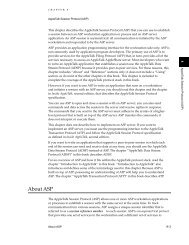URL Loading System Programming Guide - Apple Developer
URL Loading System Programming Guide - Apple Developer
URL Loading System Programming Guide - Apple Developer
Create successful ePaper yourself
Turn your PDF publications into a flip-book with our unique Google optimized e-Paper software.
Authentication Challenges and TLS Chain Validation<br />
Performing Custom TLS Chain Validation<br />
If the delegate doesn’t implement connection:didReceiveAuthenticationChallenge: and the request<br />
requires authentication, valid credentials must already be available in the <strong>URL</strong> credential storage or must be<br />
provided as part of the requested <strong>URL</strong>. If the credentials are not available or if they fail to authenticate, a<br />
continueWithoutCredentialForAuthenticationChallenge: message is sent by the underlying<br />
implementation.<br />
Performing Custom TLS Chain Validation<br />
In the NS<strong>URL</strong> family of APIs, TLS chain validation is handled by your app’s authentication delegate method,<br />
but instead of providing credentials to authenticate the user (or your app) to the server, your app instead<br />
checks the credentials that the server provides during the TLS handshake, then tells the <strong>URL</strong> loading system<br />
whether it should accept or reject those credentials.<br />
If you need to perform chain validation in a nonstandard way (such as accepting a specific self-signed certificate<br />
for testing), your app must do the following:<br />
●<br />
●<br />
For NS<strong>URL</strong>Session, implement either the <strong>URL</strong>Session:didReceiveChallenge:completionHandler:<br />
or <strong>URL</strong>Session:task:didReceiveChallenge:completionHandler: delegate method. If you<br />
implement both, the session-level method is responsible for handling the authentication.<br />
For NS<strong>URL</strong>Connection and NS<strong>URL</strong>Download, implement the<br />
connection:canAuthenticateAgainstProtectionSpace: or<br />
download:canAuthenticateAgainstProtectionSpace: method and return YES if the protection<br />
space has an authentication type of NS<strong>URL</strong>AuthenticationMethodServerTrust.<br />
Then, implement the connection:didReceiveAuthenticationChallenge: or<br />
download:didReceiveAuthenticationChallenge: method to handle the authentication.<br />
Within your authentication handler delegate method, you should check to see if the challenge protection<br />
space has an authentication type of NS<strong>URL</strong>AuthenticationMethodServerTrust, and if so, obtain the<br />
serverTrust information from that protection space.<br />
For additional details and code snippets (based on NS<strong>URL</strong>Connection), read “Overriding TLS Chain Validation<br />
Correctly”.<br />
2013-10-22 | Copyright © 2003, 2013 <strong>Apple</strong> Inc. All Rights Reserved.<br />
57
















